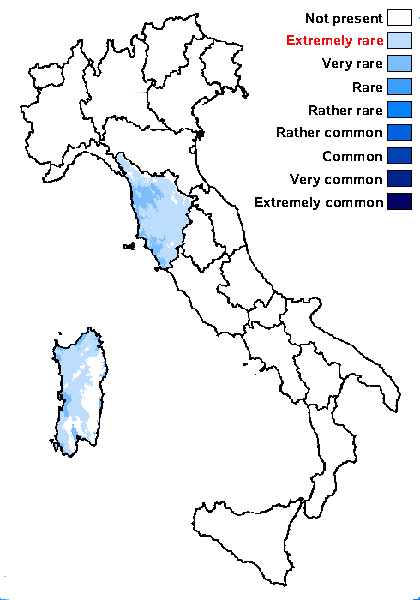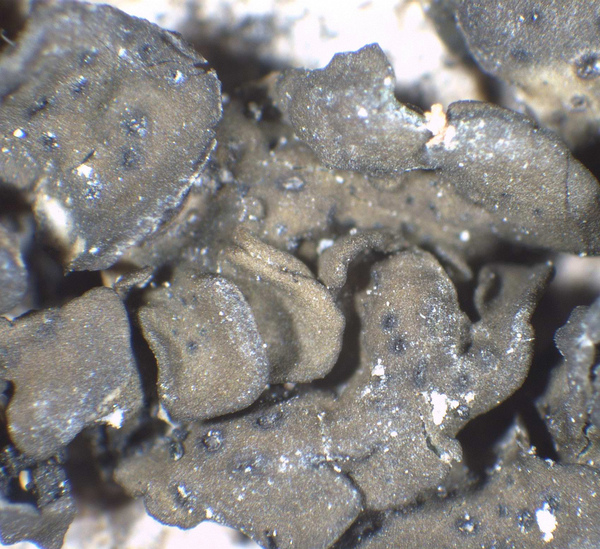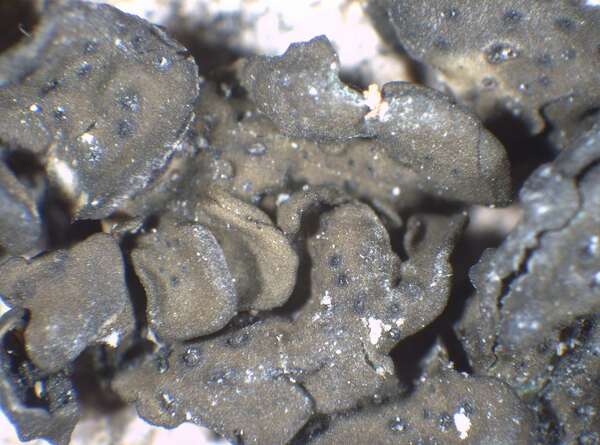Peltula omphaliza (Nyl.) Wetmore
Ann. Missouri Bot. Gard., 57: 194, 1970. Basionym: Heppia omphaliza Nyl. in Eckfeldt - Bull. Torrey Bot. Cl., 16: 106, 1889.
Synonyms: Heppia subguepini Werner
Distribution: C - Tosc, Sar.
Description: Thallus foliose- or squamulose-umbilicate, peltate, consisting of convex, up to 2 mm wide squamules with smooth, entire or slightly lobed, often wavy margin; upper surface dark olive-brown to black, esorediate; lower surface paler than upper surface, attached by a central holdfast. Upper cortex not developed, but upper surface with a yellowish epinecral layer; medulla of loosely interwoven hyphae and large air spaces; lower cortex up to 40 µm thick, consisting of 3-5 layers of cells. Apothecia 5-20 per squamule, immersed, with an initially punctiform, later very slightly expanded, 0.1-0.2 mm wide, reddish brown to dark brown disc. Proper exciple thin; epithecium yellow-brown, K+ red-violet or K-; hymenium colourless, I+ wine-red, K/I+ pale blue except near the asci which react K/I+ intensely blue; paraphyses thin, sometimes anastomosing, rarely branched, the apical cells slightly swollen; hypothecium colourless. Asci >100-spored, clavate to obclavate, rostrate, the wall I+ orange, K/I+ blue. Ascospores 1-celled, hyaline, ellipsoid to bacilliform, 5-7 x c. 3 µm Pycnidia immersed, spherical. Conidia fusiform, 2.4-3.1 x c. 1.2 µm. Photobiont cyanobacterial, chroococcoid, one-celled. Spot tests: thallus and medulla K-, C-, KC-, P-. Chemistry: without lichen substances.Note: on steeply inclined seepage tracks of basic siliceous rocks, with optimum in the Mediterranean belt; more thermophilous than P. euploca, and much less common in Italy.
Growth form: Foliose, umbilicate
Substrata: rocks
Photobiont: cyanobacteria, filamentous (e.g. Nostoc, Scytonema)
Reproductive strategy: mainly sexual
On otherwise dry surfaces with short periods of water seepage after rain
Commonnes-rarity: (info)
Alpine belt: absent
Subalpine belt: absent
Oromediterranean belt: absent
Montane belt: absent
Submediterranean belt: absent
Padanian area: absent
Humid submediterranean belt: extremely rare
Humid mediterranean belt: very rare
Dry mediterranean belt: very rare

Predictive model
Growth form: Foliose, umbilicate
Substrata: rocks
Photobiont: cyanobacteria, filamentous (e.g. Nostoc, Scytonema)
Reproductive strategy: mainly sexual
On otherwise dry surfaces with short periods of water seepage after rain
Commonnes-rarity: (info)
Alpine belt: absent
Subalpine belt: absent
Oromediterranean belt: absent
Montane belt: absent
Submediterranean belt: absent
Padanian area: absent
Humid submediterranean belt: extremely rare
Humid mediterranean belt: very rare
Dry mediterranean belt: very rare

Predictive model
 Index Fungorum
Index Fungorum
 GBIF
GBIF




